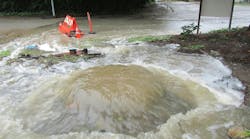Dirty Job
Kelly Kolpak is marketing coordinator for RJN Group. Kolpak can be reached at [email protected]. Vincent Bergl, P.E., is project manager for RJN Group. Bergl can be reached at [email protected].
undefinedOverflows are messy, costly, annoying, disruptive and dirty—but whichever adjective is used to describe them, the usual follow-up questions are “What caused this?” and “How is it going to be fixed?”
Overflows happen both in combined sewers as well as sanitary sewers and are referred to as combined sewer overflows (CSOs) and sanitary sewer overflows (SSOs). They can occur due to an operation and maintenance (O&M) issue and/or capacity limitations.
Common O&M issues include blockages from roots, debris, collapsed pipe and junk. Lift station problems such as a pump failure or power outage also are considered O&M issues that can lead to overflows.
Overflows caused by capacity limitations most often are attributed to undersized pipe, insufficient treatment plant capacity, excessive inflow/infiltration (I/I), and/or extreme wet-weather events (for instance, heavy snow melt or rain).
Distinctions Between CSOs & SSOs
CSOs and SSOs are not the same; in fact, each has significant distinctions.
The “C” in CSO stands for combined, but it also can be associated with the word “control.” Often, CSOs actually are designed to occur at monitored control structures. For example, weirs, dams, flap gates, control valves and flow restrictors are all meant to control overflows. CSOs typically take place when treatment capacity has been exceeded, and the excess volume flows into surface waters such as rivers and lakes.
There is rarely control involved in SSOs. In the most common case, pipe capacity in the sanitary sewer has been exceeded for one reason or another, and overflows begin to occur, often in several locations at once. Manholes overflow, and streets and basements flood. The wastewater components of SSOs are less diluted than CSOs.
An impetus for a control program will happen whether the community is experiencing SSOs or CSOs, but that impetus can vary. Sometimes it is pressure from affected residents and/or customers; negative press; or, if left alone long enough, regulatory requirements. Regulatory requirements can include violation notices; consent decrees; capacity, management, operation and maintenance (CMOM) requirements (for sanitary systems); or Long-Term Control Plans (for combined systems).
Remedying the Situation
On the O&M side, steps that can be taken include more frequent cleaning; root cutting or chemical treatment; and repairing collapses and back-pitched sewers.
Addressing a capacity issue will require a bit more time to focus on investigation and analysis. To start with, flow monitoring and hydraulic modeling of the system will need to be done in order to establish the existing level of protection against SSOs and/or CSOs.
SSOs can be harder to track because they either have to be witnessed, e.g., by seeing the manhole or gutter overflowing, or they have to be reported, such as with basement backups. CSOs usually are monitored, because they can be tracked at the bypass structures/relief points as they occur.
The data gathered from the flow monitoring and hydraulic modeling can be analyzed to find bottleneck locations and develop alternatives for capacity improvements. Improvement options for sanitary sewer systems include upsizing the sewers, or constructing relief sewers or storage facilities. There are several improvement options available for combined sewer systems.
Implementation
To reduce CSO occurrences, the following methods can be applied:
- Attenuation and/or removal of storm water sources;
- Control structure modifications;
- Optimization or real-time controls; or
- Capacity improvements, including deep tunnel or reservoir storage and wet-weather treatment capacity.
The conclusions that are reached as to how to attenuate and/or remove storm water sources usually involve either separating the sewer system or utilizing green infrastructure.
To separate a combined sewer system, either a new sanitary system or a new storm system will need to be designed and constructed; deciding which one to build must be considered on a case-by-case basis. The existing system then will be converted into either a storm sewer or a sanitary sewer. All private laterals would go to the sanitary sewer, and all storm inlets would go to the storm sewer. A problem that could arise after separating the system is that more wet-weather flow than a treatment facility can handle can still end up leaving a community with SSOs.
Green infrastructure can help alleviate I/I from both private and public sources by taking storm water sources (such as downspouts and sump pumps) off the system without causing flooding. Green infrastructure can slow the rate at which water enters the system because less peak runoff is entering the system, whether it is combined or separate.
To mitigate SSO occurrences, the following methods can be put into place:
- Remediation of I/I sources through public sewer rehabilitation or private sector source remediation; or
- Capacity improvements through relief sewers or upsizing localized bottlenecks, treatment plant expansion, or storage tank or inline storage capacity.
Frequently the remediation of I/I sources includes field investigations such as smoke testing, dye testing and closed-circuit TV inspections. These investigative measures will determine where rehabilitation needs to be performed. In the matter of private sector sources (e.g., downspouts, sump pumps and area drains), building inspections and/or policy implementation may need to be conducted and/or put into place so that the end result will be the disconnection of these I/I sources.
Conclusion
While the trends are moving toward green infrastructure to eliminate or mitigate the impact of storm water flows, there are still times when traditional grey infrastructure remains necessary. Whichever options a community chooses, the implementation is often costly, both in terms of finances and public perception. It is vital to engage the public from the start of the decision-making process and throughout the program’s realization, because solving CSOs and SSOs is a joint effort between community leaders and the public.
Download: Here


